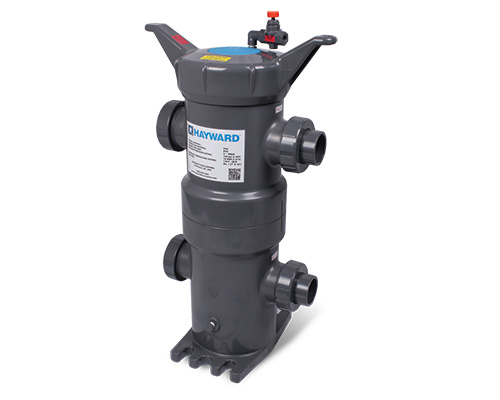
CPVC Bag Filter 01 - Hayward Flow Control
The FLV Series Bag Filter Vessels are available in durable PVC and CPVC construction, engineered with a true-union design. End connection options include socket, threaded, or flanged styles, with metric (DIN/EN) connections also offered. These vessels are especially well-suited for demanding applications such as sodium hypochlorite and bleach processing, thanks to their excellent chemical resistance.
Each unit comes standard with FPM seals, with EPDM available as an option. The vessels are pressure rated to 150 psi at 70°F non-shock. Offered in both Size 1 and Size 2 configurations, the FLV Series is available as single (Simplex), dual (Duplex), or triple (Triplex) assemblies, providing flexible solutions for a wide range of liquid filtration requirements.
Monarch Group - Australia and Thailand, are Authorised Distributors/Agents for Hayward Flow Control.
Hayward Flow Control FLT Bag Filter Housing – CPVC Construction
The Hayward FLT Series Bag Filter Housing in CPVC is a robust and dependable solution for liquid filtration across demanding industrial applications. Designed for strength, durability, and superior chemical resistance, this housing is well-suited for processes involving aggressive or high-temperature fluids, while maintaining ease of operation and minimal maintenance.
Constructed from high-performance CPVC, the FLT housing delivers outstanding resistance to corrosive chemicals such as sodium hypochlorite, bleach, acids, and caustics, making it an excellent choice for chemical processing, water treatment, and industrial fluid handling systems.
- Heavy-Duty CPVC Construction – Provides superior corrosion and temperature resistance for long service life in harsh conditions.
- True-Union Connections – Available in socket, threaded, or flanged end connections for flexible installation.
- Pressure Rated – Engineered for 150 psi (10 bar) at 70°F non-shock service.
- Seal Options – Supplied standard with FPM (Viton®) seals, with EPDM available for alternate chemical compatibility.
- Versatile Configurations – Offered in Size 01 and Size 02 housings, as well as Simplex, Duplex, or Triplex assemblies for larger flow demands.
- High Flow Capacity – Accommodates flow rates up to 100 GPM (depending on size and application).
- Easy Maintenance – One-piece construction and straightforward bag change-out reduce downtime and labor costs.
- Metric Options – DIN/EN standard end connections available for international applications.
- Superior Chemical Resistance – Ideal for aggressive chemicals and higher-temperature applications, extending equipment life.
- Cost-Effective Performance – Reliable alternative to metallic housings with reduced risk of corrosion-related failures.
- Flexible Application Range – Multiple sizes and system configurations make it suitable for both small-scale and high-volume filtration setups.
- Enhanced Safety – CPVC construction ensures leak-tight operation while eliminating corrosion by-products.
- Reduced Downtime – Quick, simple filter bag replacement improves process efficiency and keeps operations running.
The maximum recommended fluid velocity through this product is eight feet per second (8 ft/s). Higher fluid velocity can create excess water hammer effect, resulting in property damage, personal injury, or even death. Please refer to I.O.M.
| Connection | Velocity | Approx Flow Rate lt/hr | |
| DN32 | 1-1/4" | 8 feet/sec | 6,900 |
| DN40 | 1-1/2" | 8 feet/sec | 10,110 |
| DN50 | 2" | 8 feet/sec | 16,830 |
Velocity in Schedule 80 Plastic Pipe for Water - Safe Flow Velocity
Hayward establishes a generally accepted safe flow velocity for plastic piping systems. For systems without fast opening or closing valves, a maximum velocity of 8 feet per second is recommended. However, for systems equipped with such valves (like solenoid or pneumatically actuated valves lacking speed controls), the maximum velocity is typically limited to 5 feet per second. In contrast, metal piping systems are often designed to accommodate flow rates of up to 15 feet per second, significantly higher than those acceptable for plastic systems. This distinction is crucial when considering the installation of plastic components such as valves, strainers, or filters within a metal system.
Monarch Asia Pacific Pty Ltd, Copyright © 2025 All Rights Reserved
Release: 24:8:2







